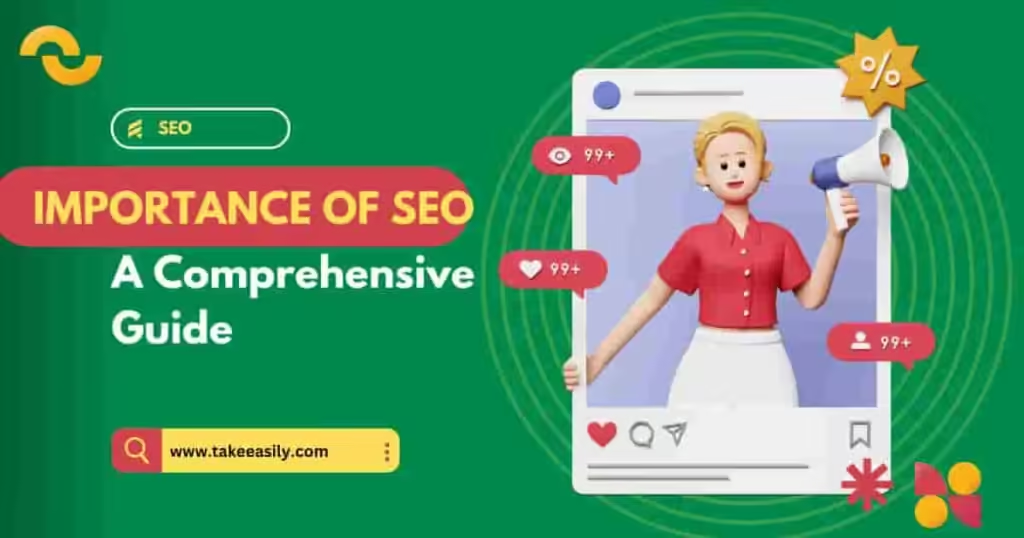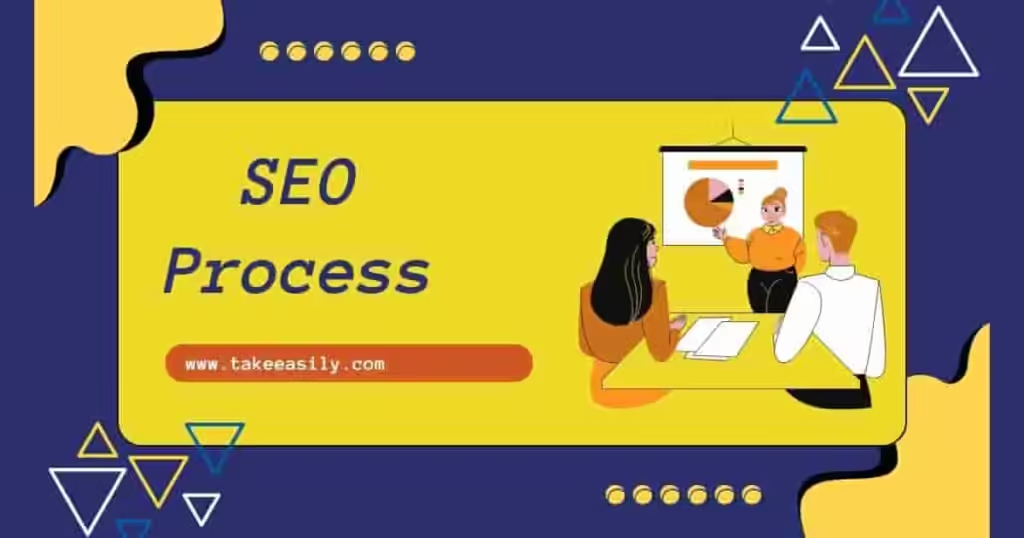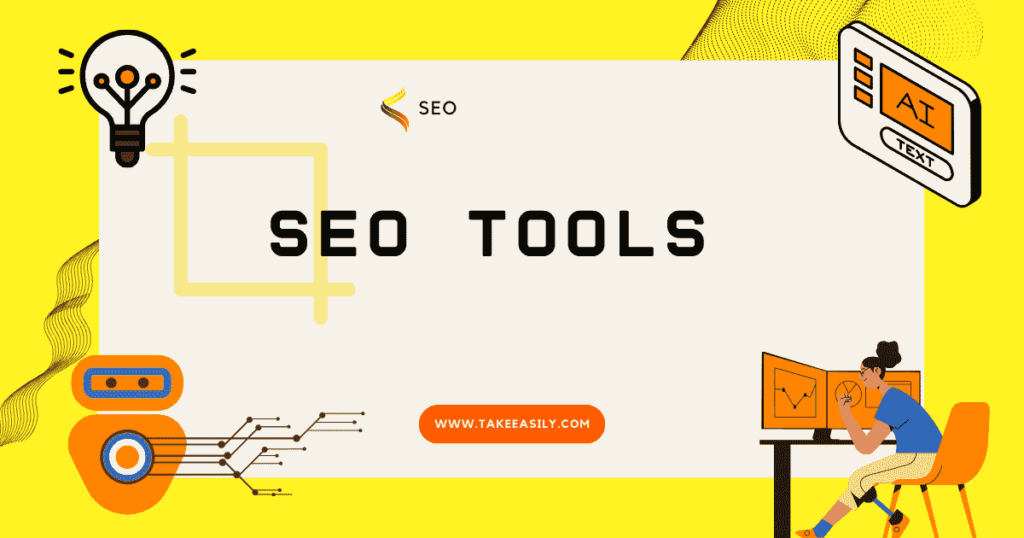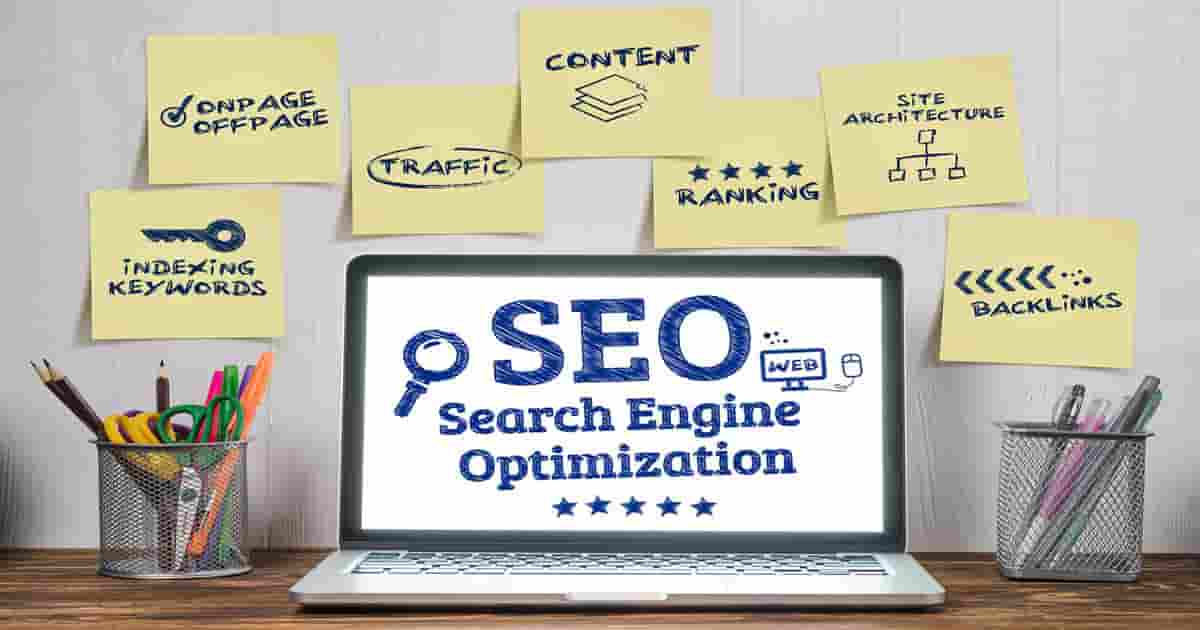This article explores the importance of SEO in digital marketing including the types of SEO, SEO process, SEO tools, and SEO mistakes.
Thus, it can be stated that SEO is the most crucial element of digital marketing. This is because the marketing competition for search engine visibility has grown as organizations convert from offline to online platforms.
Thus, for increased website visibility, the generation of organic traffic, and the overall support of the digital marketing campaigns SEO is critical. This long read analyzes the role of SEO in digital marketing and discusses different types of SEO as well as outlines the key components of an effective SEO strategy.
To understand the reasons for the importance of SEO in digital marketing, let’s first find out what SEO in digital marketing is actually about.
1. What is SEO?

The enhancement of a website to have a better ranking on search engines and thereby enhance the visibility to the users is called search engine optimization or SEO.
Proper SEO means providing the kind of content the user may find useful after posing a question. Some of them include; keyword search and writing good content, use of meta tags, and creating backlinks.
This means that every time a site is on the top page of search engine results such as Google, then the chances that it would attract more visitors and would-be consumers are high. This is done through what is known as search engine optimization which is abbreviated as SEO.
View also our latest post on Free Digital Marketing Tools
2. What is the importance of SEO in digital marketing?
Owning to the above analysis, the following are the key recommendations for unlocking success. Let’s know what benefits have increased the importance of SEO in digital marketing.

2.1. Improving awareness of the brand
One of the most effective ways of enhancing the advertising goal of a brand is to improve the brand awareness of a product or company.
Internet marketing requires visibility and it is one of the major facets of the process.
It was found that users who typed in specific keywords were highly likely to come across a website that is optimized for such keywords when they conducted their Search Engine Results Page (SERP).
2.2. Operating in Targeted Traffic
This makes SEO unique since it is capable of delivering keen targeted traffic to a website. It is an important point of difference from traditional forms of media advertising where a broad swathe of the population is reached with a message, whereas SEO seeks out consumers who, at that specific point in time, are seeking a specific content, product, or service.
This means that the traffic associated with SEO is more likely to be those people who may need what is offered by the company. By doing this, there is a greater likelihood that such users will engage with the material, remain on the web resource, and become consumers.
2.3. Economical and Extended Advantages
Another advantage of SEO is that it is cheap compared to other forms of marketing. It is essential to understand that whereas enhancing the internet site involves certain costs at the initial stage only, the subsequent benefits exceed such costs several times.
However, as with most advertising, paid advertising requires constant funding to maintain the advertisement’s presence, while SEO results can last for months and even years. When a concrete site obtains a high rating, it can attract organic traffic without further spending which shows that SEO is a sustainable and cost-effective method.
2.4. Establishing Credibility and Trust
Cutting through the noise and developing trust is paramount in today’s world of business. It is commercial knowledge that high-ranking websites tend to be perceived as being more credible and respectable.
In this way, SEO safeguards that the claimed impact – a positive impression of the website – is created through presenting top-quality content, great usability, or a safe site that loads promptly.
Therefore, receiving backlinks from reliable websites enhances the trust factor of a website for the consumers as well as the search engines to know that it is a reliable site.
2.5. Maintaining a Competitive Advantage
It becomes imperative to be ahead of the competition than the other companies in the constantly competitive world of digital marketing. Those businesses that do not optimize their sites for SEO risk being left far behind the competition that is continually improving their websites.
When targeting organization buyers, having a good SEO leads to organizations benefiting from new opportunities and trends within their field of business.
Another benefit is that it will make businesses remain relevant and adapt to any current changes in the SEO systems and user-computer interactions by optimizing them.
2.6. Enhancing the User Experience
Apart from making the website more amicable to the search engine crawler, SEO has other objectives of enhancing the users’ experience. Many of the best SEO practices enhance the user experience by suggesting such things as mobile optimization, fast-loading sites, and easy navigation.
Besides increasing the SEO results, this gives users a satisfying experience that can lead to conversion and revisits.
Read also the importance Of Digital Marketing In E-commerce
3. Types of SEO
This way, following the importance of SEO in digital marketing, You can enhance your understanding of the various types of SEOs. In this post, you will learn about the various types of SEO.
As it has been mentioned above, you already have an idea about the importance of SEO in digital marketing. Now, you must understand all the types of SEO to come up with a comprehensive SEO plan.
3. 1. On-Page SEO
On-page SEO is the optimization of a single web page to achieve a better search engine ranking and attract more relevant visitors. Crucial elements of on-page SEO include:
- Keyword research: searching for the right keywords and phrases that the potential customers might type in the search engines when searching for products or services.
- Information Quality: Creating timely, relevant, and quality content to satisfy the laid down information requirements of the target market.
- Meta Tags: To improve the click-through rates and search engine ranking, improve the header tags, meta description, and title tags.
- URL Structure: Be certain URLs are distinct, meaningful, and keyword-saturated.
- Internal Linking: To help search engines understand the hierarchy and relationship of sites, and produce an order and clear internal linking structure.
3.2. Off-Page SEO
Off-page SEO or off-link SEO is the methodology of promotions that is carried out outside the website in an attempt to make the website popular among search engines. Some essential components of off-page SEO are:
- Backlink building: Gaining more credibility and reliability of a site by having several reliable sites linking to it
- Social Media Engagement: To increase the traffic of the website and also to advertise and share content on social media platforms.
- Guest blogging: Writing and selling articles to other websites as a technique of getting exposure and backlinks.
- Influencer Outreach: Partnering with influencers in sharing the content and how to attract quality backlinks.
3.3. Technical SEO
Technical SEO is focused on the compliance of all technical prerequisites of a website by making its technical aspects friendly for the search engine. Some essential components of Technical SEO are:
- Site Speed: Ensuring that the site is fast to load to increase the visitors’ experience and search engine rankings is one of the best aspects of technical SEO.
- Mobile optimization: Making alterations to the layout and structure of the website in response to the increased number of visitors who are using smartphones and other portable devices to reach the destination.
- Secure Connections (HTTPS): One of the signals is HTTP which is used for having a secure connection through the search engines and hence has an impact on the ranking.
- XML Sitemaps: For better search engine spiders’ crawling and to help spiders understand the layout of the website, use and submit XML sitemaps.
- Robots. txt: An example of reaching out to search engine crawlers is use of the robots for directing the crawlers. txt file concerning which pages should be indexed and which ones should not.
3.4. Local SEO
Local SEO is the primary technique of making a site highly accessible to local visitors and this is essential for companies that have a physical location. Crucial elements of local SEO include:
- Google My Business: To enhance visibility on the local search results, one needs to open a Google My Business account.
- NAP Consistency: Ensuring that consistent NAP appears on all the web pages of the company.
- Local Citations: Registering your business establishment on other relevant websites and local directories.
- Local Keywords: Providing content for optimization with local keywords will attract local visitors.
- Customer Reviews: You have to compel customers to leave their positive reviews on Google and other platforms.
3.5. Content SEO
Content SEO aims at creating and optimizing content in a bid to improve SERPs and lure organic visitors. Important components of SEO for content are:
- Keyword optimization: Organic integration of relevant keywords within the article hence raising its search visibility.
- Content Quality: Developing content that is thought to be useful and entertaining and which meets the needs of the target audience.
- Information Length: For information to be useful to its users and to improve search results it should be comprehensive.
- Multimedia components: To garner user interest and further enrich the content employ movies, infographics, and other multimedia products.
- Material Structure: To make it easy for the user to read and understand the information presented to them, categorize it under separate headers and subsections, as well as using bullet points.
3.6. E-commerce SEO
E-commerce SEO mainly focuses on enhancing exposure and traffic to the product pages of an online business. An essential component of SEO for e-commerce is:
- Product Descriptions: For optimal search results the uniqueness and keyword incorporation in the product description should be well developed.
- Product photos: Optimizing the images that are used for the products through the use of alt tags and descriptive names for files used.
- Product Reviews: Buyers are urged to write reviews to enhance credibility as well as improve the search engine rank.
- Category Pages: This involves the incorporation of proper keywords and great content to the optimization of commonly used categories.
- Site Structure: To also improve on the usability and how search engine crawlers access the site, the site has to be well organized.
As the importance of SEO in digital marketing is going to be more demanding in the future, then the following types of SEO can assist in improving your SEO knowledge.
Read also the effective digital marketing tips for small business
4. Unlock Expert SEO Process
Probably, you have already learned about the importance of SEO in digital marketing, types of SEO, and the elements of an SEO plan. But now I will discuss one more interesting topic with you, which is the SEO Process.
It can be beneficial for anyone who wants to master SEO to improve his website’s rank. Here’s a quick start guide to learning the SEO process:

- 4.1. Recognize the Fundamentals:
SEO is short for Search Engine Optimization and it is the process of optimizing websites in a way that makes them more attractive to search engines to enhance their position on search engine results list.
Essentials to be learned include keywords, UX, off-page SEO, technical SEO, and on-page SEO.
- 4.2. Internet Sources:
Blogs and Articles: Hence, literature like Ahrefs, Moz, and Search Engine Journal offer detailed analysis rates and relevant data on SEO trends.
Google’s SEO Starter Guide: This essential resource comes directly from the market leader in terms of search engines.
YouTube: There are great video instructions on channels, such as Ahrefs, Backlinko, and Neil Patel.
- 4.3. Education and Certification:
Free Courses: The course on SEO they offer is freely available there and can be found on Google’s Digital Garage. I then identified two more first-rate sources of free training: Moz Academy and HubSpot Academy.
Paid Courses: LinkedIn Learning, Udemy, Coursera, etc., offer extensive courses quite often led by industry leaders for a fee.
- 4.4. Real-World Experience:
Launch a Blog or Website: Create your blog or website and apply all SEO techniques. It is also helpful to have practical experience in competitions where students are required to compete as part of their coursework.
Volunteer or Intern: To gain real-life experience, use the SEO services that you have learned to help companies or nonprofit organizations closely situated within your region.
- 4.5. The tools and Programs:
Google Analytics and Google Search Console: Substantial tools used in tracking as well as evaluating the impact of websites on an organization.
SEO Tools: You should learn how to use and interpret the results from tools including Yoast SEO, Ahrefs, Moz, and SEMrush. Some of them can be used for site audits, performance checks, and keyword research.
- 4.6. Remain Current:
Follow Industry Leaders: Mentioning, there is always a possibility to find out the latest tendencies and functions of algorithms associated with SEO with the help of such experienced SEO specialists as Neil Patel, Rand Fishkin, and Brian Dean.
Join Communities: Get involved with community and forums such as the SEO community on Reddit or subform on Webmaster World.
- 4.7. Practice and endurance:
Continuous Learning: It is therefore important to note that the SEO world is constantly changing. For Malala, her advice is — Go on learning, go on asking questions.
Be patient: The SEO results are made known over time as it is a process that takes time. Applying all that you have learned, do so with a lot of patience and exercise a lot of patience.
These methods will assist you in gradually building knowledge regarding the SEO Process, different types of SEO, and the importance of SEO in digital marketing, which will lead to proper optimization and improvement of the website performance.
5. Essential SEO Tools and Software
It takes time and energy to search for a website that must be ranked better by using SEO tools & software. Some SEO tools and software are for you:

5.1. SEO Tools for Researching Keywords
- Google Keyword Planner: With this free tool, one can get information on potential keywords and volumes of their usage. It’s really useful for understanding what the audience wants from a given context to establish a good starting point.
- Ahrefs: The tool has been widely used for its huge keyword list and it provides a broad keyword study with further related keywords, search volume, and keyword competition.
- SEMrush: One of the main strong sides of Glance is that each user can perform new keywords and analyze the keyword strategies of competitors.
5.2. SEO Tools for On-Page SEO
- Yoast SEO: One of the most used WordPress SEO plugins, Yoast SEO assists users to improve the on-page SEO factors including title tags, meta descriptions, and keywords.
- Moz Pro: Interestingly, Moz provides a score for optimization as well as on-page suggestions or recommendations for changes.
5.3. Technical SEO Tools:
- Google Search Console: This tool is useful when it comes to monitoring and indexing a website within Google’s search engine. It helps in the identification of crawl mistakes, indexing errors as well as other issues.
- Screaming Frog SEO Spider: It ensures a site is Search Engine friendly by indexing it and then identifying errors such as links, content duplication, and redirected chains.
5.4. SEO Tools for Analyzing Backlinks
- Ahrefs: Not only does Ahrefs feature keyword research but it does it incredibly well when it comes to backlink analysis as well. They can share data on backlinks on a given website, and identify prospects for link building.
- Majestic: This backlink analysis specialist offers domain authority reports, distribution of the anchor text, and backlink history reports.
5.5. SEO Tools for Tracking Performance
- Google Analytics: This free tool tracks the users’ navigation and traffic on the websites and provides comprehensive reports on the users’ behavior on a specific site.
- SEMrush: Doing the keyword research you also receive tools concerning the overall site performance, including the organic traffic, the current position of the chosen keywords, and the site audit tools.
5.6. All-inclusive SEO tools:
- Moz Pro: Instead a vast collection of SEO services comprising rank checker, website analytics, and keyword suggestion.
- SEMrush: Praised for its vast features, SEMrush addresses the multiple aspects of SEO, including, but not limited to, competitor analysis, site auditing, and keyword discovery.
These SEO tools are invaluable when it comes to getting a handle on the SEO of a website because they tell you what needs fixing and where to start.
6. Critical SEO Mistakes: You need to avoid
Below is a list of typical SEO mistakes that should be avoided together with recommendations on how to do that.
6.1. Inadequate Keyword Research:
During the process of keyword research, such errors as targeting irrelevant or overly competitive keywords can be made. To get the most suitable keywords with moderate competition and traffic, one should use Ahrefs, SEMrush, and Google Keyword Planner.
6.2. Poorly Optimized Content:
On-page SEO factors such as titles, meta descriptions, and headings can be an issue if neglected and their impacts reduce a page’s visibility. Ensure that all the pages of the site are properly headed and the meta tags are clear and different with an emphasis on the keywords.
6.3. Overuse of Keywords:
If one tries to cram as many keywords as possible into the content then the strategy turns into what Google and other search engines do not like – keyword stuffing. Make it a rule to always try to integrate the keywords naturally into the text and remember that good content must always take priority over quantity.
6.4. Ignoring Technical SEO:
Some of the features or issues that impact performance, refer to such aspects as pages with broken links and slow loading, and pages that have not been optimized for the mobile platform. I found out that I should schedule tools such as Screaming Frog or Google Search Console for the periodical audit of the website to identify the technical issues that need to be resolved.
6.5. Inadequate Content Depth:
Lack of content length or what I term as shallow content is bad for the users and search engines. Products should be informative, clear, and educational so that readers gain something new from them.
6.6. Low-Quality Backlinks:
This, in turn, means that by trying to get backlinks from likes of such sites, the authority of your website will be negatively affected. First, target the development of high-quality backlinks using outreach, content marketing, and guest post strategies.
6.7. Not Using Analytics:
Potential opportunities are wasted when the website’s performance is not evaluated and adjustments are not made accordingly. Monitor the user activity, traffic, and conversion rates and use Google Analytics to optimize strategy over time.
6.8. Not Optimizing for Mobile:
If a site is not optimized for mobile devices, then it will be prone to losing a lot of traffic since mobile devices have become more popular nowadays. Ensure that your website functions perfectly in the use of the tablets, and is fully mobile.
6.9. Problems with Duplicate information:
If the information on your Web site is duplicated, search engines may get lost and your rank is reduced. It is crucial that all pages are unique, and utilize canonicals.
6.10. Ignoring Local SEO:
It means if businesses serving the target local clientele do not focus on local SEO chances can slip through their fingers. Ensure your Google My Business listing is up to date; accumulate reviews from customers and use local keywords.
One way you can help your website run at its best, increase its rankings, and attract organically more visitors is to avoid these common mistakes in SEO.
7. Last Words
In conclusion, search engine optimization (SEO) is a core segment of web marketing that has several benefits such as usability, affordable and selective exposure, and traffic. It is for this reason that businesses can gain credibility and trust, win customers over competitors, and see their firms transform into sustainable, long-term growth models when they invest in SEO.
The importance of SEO in digital marketing in the present world that is driven by digital can hardly be overemphasized and therefore makes it a key strategy for any corporation wishing to thrive on the web.
I think you have got a clear idea about the importance of SEO in digital marketing, the types of SEO, learning the SEO process, SEO tools, and SEO mistakes.
Thanks for keeping up with the post. Let it be until today. Some day in the future I will discuss the other related things of the importance of SEO in digital marketing. Until then stay well, stay healthy.

I am a content writer and English educator with over 10 years of professional experience. With a master’s degree in English Language and Literature, I specialize in creating educational content that is clear, practical, and easy to understand. As the founder of TakeEasily.com, I’m dedicated to helping students, parents, and teachers with valuable learning resources and insightful guides.


8 thoughts on “The Importance of SEO in Digital Marketing: 6 Unique Reasons”
Comments are closed.